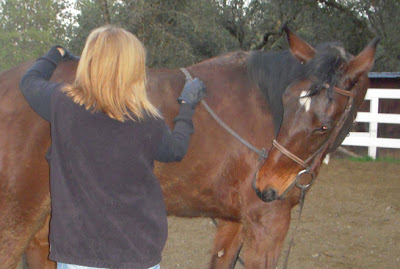What is it?
What is it with girls and horses?
So sings country girl/horse lover Templeton Thompson in her hit song.
Those of us who love horses (not just Standardbreds, but horse of all shapes, sizes, colors and breeds)...we "get it."
But a few months ago, I got the question again, this time from the dad of two horse crazy girls who ride with me.
"I just don't, I don't know..." The dad paused, scratched his head. "I just don't get it. I mean, what's it doing for them?"
Ooo...don't get me started!
I said, "They are learning responsibility, compassion, perseverance, courage, and discipline. They are learning to overcome fears, to think of something other than themselves. They are learning how to use their bodies in an athletic manner. They are developing core strength, balance, and centeredness that is both physical and mental."
But these photos of 10-year-old Emma say it all. Emma is learning how to ride on board Max,. Max is older sister Olivia's horse. Oliva is now focusing on training her new, young Standardbred/Friesian cross. Which means Max is now helping Emma learn to ride.
Max. who is in his early 20's, was born in Washington State under the name Paragon. This big, buttery chestnut thoroughbred followed his short, unremarkable racing career with very remarkable forays into show jumping, three-day eventing, fox hunting and drssage. He and former owner Evie Holt took first place at Pony Club Nationals in Freestyle Dressage when Max was 16 years of age..
And now, he lives a quiet life with a loving family, who appreciates how this gentle giant takes care of "his girls. " He helped give Olivia the skills she is now using to train her new horse; now Emma is following the same path.
So, along with all my usual reasons for the girl-horses combination--and what we learn from them--here comes Emma to remind me of the ultimate reason we love horses and love riding them.
It's the joy! It's all about the joy!
I'm keeping this photo on my desk, where I can see it all the time. There is simply no way I can be in bad mood when I look at it!
Thanks, Emma, for lifting my heart!



